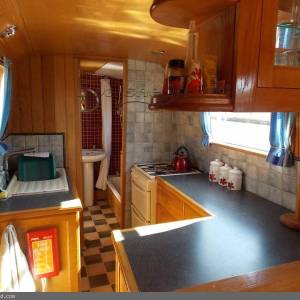
Four Sure-Fire Ways to Power Your Galley
Canal boat kitchens can range from basic to luxurious, and can include a Rayburn, dishwasher and washing machine - with a decent water and electric supply! However, your available power will dictate to some extent what facilities you can have on board.
1) Gas
A standard facility fitted onto most modern narrowboats is a bottled gas supply. This can be used for cooking and heating, and will even power a fridge! There are two main choices; Butane which comes in blue bottles, and Propane which is delivered in orange bottles. In very cold weather Butane may remain liquidised instead of evaporating to gas as it leaves the bottle. This will leave you unable to use the gas supply and could be dangerous. I remember this happening to me on my first liveaboard boat. There’s nothing worse than being unable to even boil a kettle on a cold day! Propane is therefore the most common choice for boaters who live aboard all year round.
The EU recreational craft directive and the boat safety scheme stipulate a number of safety guidelines for both gas and electric services on board. The rules for gas installations include storing gas bottles into a locker fitted above the waterline, with ventilation holes at the bottom to allow any gas leaks to escape.
2) Diesel
Red diesel can supply and power your heating and oven but the units can be expensive. Diesel that is used for domestic purposes rather than propulsion is sold at a cheaper rate, but you may need to expand your fuel tank to be able to store the amount you will need.
3) 12 Volt Electric
Many modern appliances require more power than 12 volt electric systems can comfortably supply, but for boats there are specially designed fridges and freezers available which will run off of 12 volt. These are very popular and 12 volt fridges are commonly installed on most UK narrowboats; although some canal boat fridges are powered by gas.
4) 240 Volt Electric
Something we take for granted when living ‘on the bank’ is 240 volt power. On a boat this can be delivered via a 12/240 volt inverter, a generator or shore line electric. An inverter can draw Direct Current from the batteries on board, and convert it into 240 AC. Depending on the number of appliances you want to run you may like to install a few extra batteries! A self-contained generator can deliver high outputs of over 2.5 Kilowatts, and is suitable for powering high drain appliances but they can be noisy, expensive and take up valuable storage space. A permanent marina mooring may provide shore line electricity but bear in mind that this will not be available whenever you are out and about enjoying a cruise. The advantage of having a 240 volt set up of course is that you could enjoy dishwashers, washing machines, driers, toasters and microwaves should you wish!
Galleys can differ from boat to boat with some offering simple facilities and some offering all mod cons. If you’d like to compare what kitchens are available, browse around our site, or check out last week’s article: Three Kitchens That Are Cooking on Gas.
Image: Narrowboat 50ft Cruiser Stern for sale (Hemel Hempstead)
Peggy Melmoth
600,000 registered boat buyers
Sell your boat twice as fast
150,000 unique visitors per month
1000+ boats sold per year
50+ Boatshed branches world-wide
You may also like:
Living on a Boat: The Boatshed Guide (free) / How to Sell a Boat: The Ultimate Guide (free eBook) / How to Buy a Boat: The Ultimate Guide / Our Top 5 Articles From 2014 / Don’t miss:The Boatshed Grand Union Daily/ More articles.
New here? Come and say 'hello' on Facebook or Twitter :-)
Never miss an article: Sign up and get the latest blog articles sent directly to you, plus instantly receive our free eBook: How to Sell a Boat: The Ultimate Guide.

